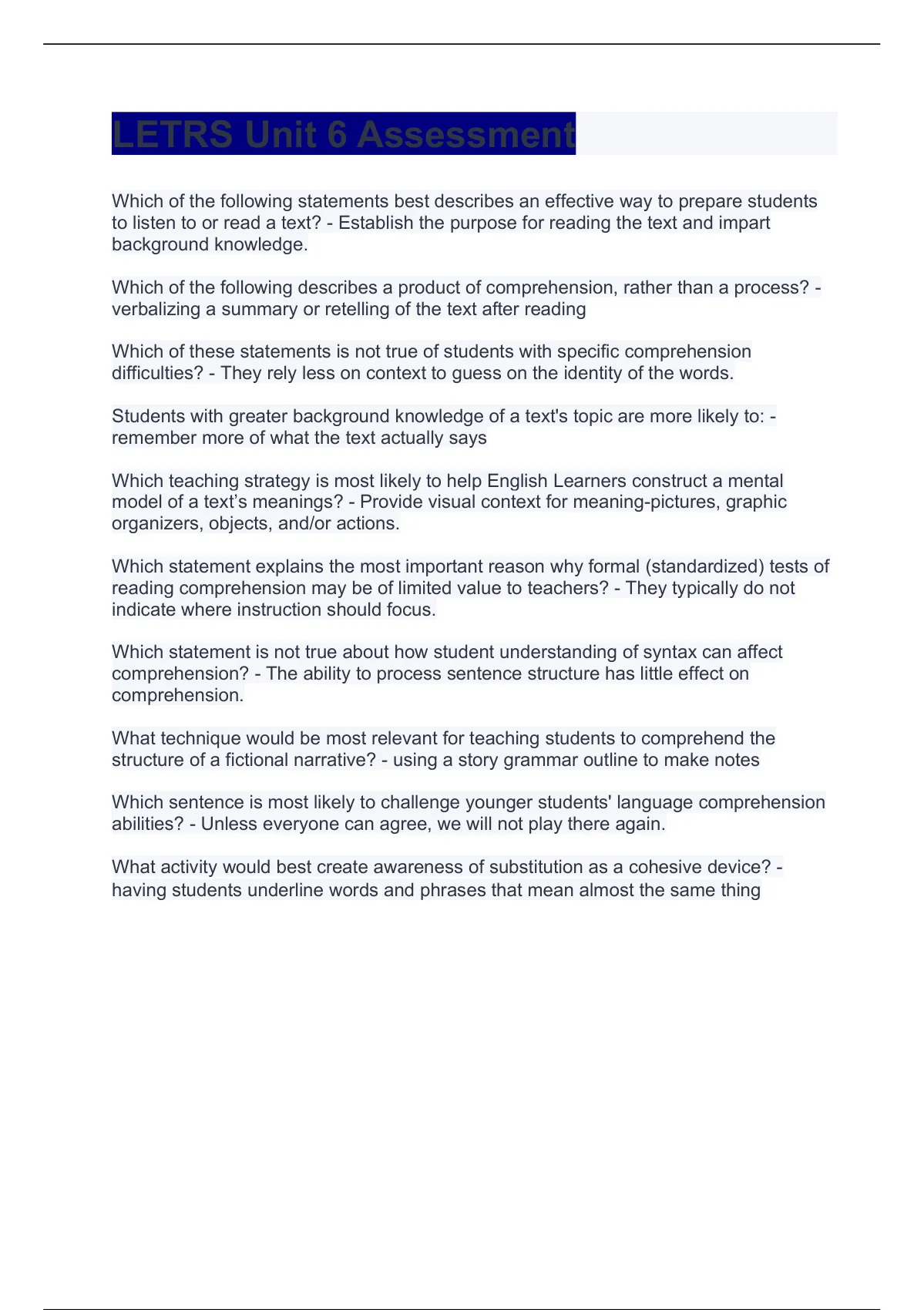Imagine a child struggling to decode a simple word. They sound out each letter individually, but the meaning remains elusive. The frustration mounts, and the joy of reading fades. This scenario plays out in classrooms across the nation, leaving teachers grappling with how to best support struggling readers. Enter LETRS, a comprehensive program designed to equip educators with the science-based knowledge needed to unlock literacy for all students. LETRS, or Language Essentials for Teachers of Reading and Spelling, is a groundbreaking professional development program that empowers educators to transform their teaching practices and effectively address the needs of diverse learners.

Image: www.coursehero.com
This article focuses on LETRS Unit 1 Session 2, diving deep into the fundamental concepts of phonemic awareness and its role in successful reading and spelling development. We will explore the key takeaways from this session, offering insights and actionable strategies that you can implement to guide your students towards confident literacy.
Decoding the Foundations of Literacy: A Deep Dive into LETRS Unit 1 Session 2
LETRS Unit 1 Session 2 dives headfirst into the crucial concept of phonemic awareness – the ability to hear, identify, and manipulate individual sounds (phonemes) within spoken words. Think of it as the foundation of literacy, paving the way for successful reading and spelling. This ability is the cornerstone of early literacy development, acting as a gateway to unlocking the world of words.
Understanding Phonemic Awareness: More Than Just “Sounding Out”
It’s important to grasp that phonemic awareness is not simply about “sounding out” words. It encompasses a range of skills, including:
- Identifying the first and last sounds in a word: This ability helps students recognize the initial and final phonemes, crucial for decoding and spelling.
- Isolating specific sounds: This skill allows students to focus on individual phonemes within a word, building the foundation for blending and segmenting.
- Blending sounds to make words: This is a key skill in decoding, allowing students to combine individual sounds to create a whole word.
- Segmenting words into sounds: This is essential for spelling, enabling students to break down words into their component sounds to write them accurately.
- Deleting sounds from words: This helps students manipulate sounds within words, enhancing their phonemic awareness.
- Substituting sounds: This skill involves replacing one sound with another in a word, further strengthening their ability to manipulate sounds.
The Power of Phonemic Awareness: Why It Matters
When students develop strong phonemic awareness, they build a solid foundation for:
- Decoding: They can easily sound out words, breaking them down into their individual sounds to quickly recognize the word.
- Spelling: They can correctly spell words by segmenting them into individual sounds, then representing each sound with a letter.
- Reading Fluency: As students become confident decoders, their reading becomes smoother and more fluent.
- Reading Comprehension: Strong phonemic awareness allows students to focus on the meaning of the text, rather than struggling with decoding individual words.

Image: www.stuvia.com
LET’s Get Practical: Applying the Knowledge
The beauty of LETRS is that it’s not just about theory. It provides educators with practical strategies and activities to foster phonemic awareness in their students. Here are some key takeaways from LETRS Unit 1 Session 2 that you can implement in your classroom:
- Use engaging games and activities: Turn learning into fun with activities like sound matching, sound isolation, and rhyming games.
- Utilize manipulatives: Incorporate tools like blocks, counters, or picture cards to represent sounds visually, making the learning process more concrete.
- Focus on oral language: Create a classroom environment rich in language, encouraging conversations, storytelling, and poetry.
Addressing Common Challenges: Recognizing and Responding
LET’s be real: not all students are at the same level of phonemic awareness. Some students quickly grasp these concepts, while others might need additional support. LETRS emphasizes the importance of differentiated instruction to meet the diverse needs of learners. Here are some important tips:
- Assess your students: Conduct ongoing assessments to identify the strengths and weaknesses of each student in phonemic awareness.
- Provide targeted interventions: Offer extra support to students struggling with specific phonemic awareness skills, using a variety of individualized strategies.
- Collaborate with colleagues: Share ideas and resources with other teachers to best support students with varying levels of phonemic awareness.
LET’s Go Beyond the Classroom: Building a Supportive Learning Ecosystem
Remember, fostering phonemic awareness isn’t solely the responsibility of the classroom teacher. It takes a village, and you can play a vital role in extending the learning beyond the classroom walls.
- Partner with parents: Inform parents about the importance of phonemic awareness, providing resources and suggestions for activities to reinforce these skills at home.
- Connect with the community: Seek out opportunities to engage with local libraries, museums, and other community organizations that promote reading and language development.
Letrs Unit 1 Session 2 Check For Understanding Answers
The Enduring Legacy of LETRS: Empowering Educators
LET’s face it: LETRS isn’t a one-time training program; it’s a valuable resource that continues to support educators throughout their careers. The program’s comprehensive approach ensures that teachers develop a deep understanding of the science of reading, empowering them to create an enriching learning environment for all students.
By embracing the key takeaways from LETRS Unit 1 Session 2, you’ll be equipping your students with the foundational skills needed to become confident readers and lifelong learners. Remember, every student deserves the opportunity to unlock the magic of language and unlock their full potential. LETRS is your guide to making that dream a reality.





